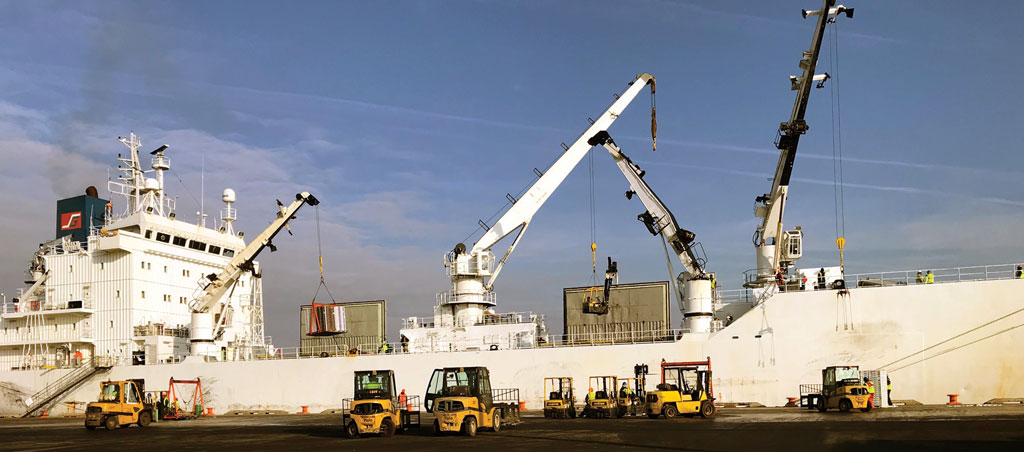With existing facilities virtually maxed out, the Delaware State Port Corp.’s Port of Wilmington is looking to have in place by midyear a private-sector terminal operator for its present 308-acre site, as well as for development of a recently acquired 112-acre waterfront tract a few miles farther up the Delaware River.
While John Haroldson, the port’s longtime director of marketing, told AJOT that the timeline “should not be framed as a certainty” as “this is a sensitive and political issue,” he said hopes are that the partner will be in place by July 1, the start of the port’s next fiscal year.

Whereas, according to Haroldson, there are “several semifinalist groups” that have submitted qualified proposals, the partner has yet to be selected in a review process in which the DSPC board and two consultant groups are engaged.
The pursuit of a public-private partnership, or P3, stems from a 2016 strategic master plan by AECOM consultants that, according to Haroldson, “validated that neither the port nor state had the financial resources to sustain the port’s operations for an extended period.”
The additional tract, which formerly was the location of the Chemours/DuPont titanium dioxide manufacturing plant at Edgemoor, was among sites identified by AECOM as holding promise for expansion of Port of Wilmington operations. Three miles up the Delaware River from the present facilities, the waterfront Edgemoor property is still within 70 miles of Atlantic Ocean waters. AECOM estimated development costs totaling nearly $500 million for building a two-berth marine terminal with potential annual throughput of almost 1 million 20-foot-equivalent container units.
The Edgemoor site was acquired for $10 million in February 2017, and the state promptly solicited qualifications from operators, developers and investors interested in taking over operations on the existing port footprint and in development and operation at Edgemoor.
“This would be accomplished through a long-term concession agreement that would require the operator to invest hundreds of millions of dollars to grow business and jobs,” Haroldson said. “The prime condition for any resultant agreement is that the State of Delaware ultimately retains ownership.
“In return,” he said, “the operator guides the strategic direction of the terminals and manages the day-to-day operations. The state can then redirect funds from port support to education, roads and so on, while the port becomes an even more efficient economic engine.”
The goal is to identify the best qualifier by early 2018 and begin negotiation of terms to facilitate endorsement by the DSPC board for presentation to the Delaware General Assembly.
“With the state’s approval, due diligence would continue and the new operator would take over in 2018,” Haroldson said. “There are still many details to be worked out. However, the ultimate objective is a worthy one, and the process to date is proceeding favorably.”
Meanwhile, the DSPC has been moving forward with enhancements at the present site, on which the Port of Wilmington was founded in 1923, at the confluence of the Christina and Delaware rivers.
Most notably, the port last year put two new rail-mounted ship-to-shore gantries into service, doubling such capacity in Wilmington, and completed reconstruction at Berth 5, allowing gantries to serve Berth 1 through Berth 5 on the Christina River. With the port’s 100-ton-capacity mobile harbor crane able to furnish heavylift and container service at those five berths plus Berth 7, shore crane service is now available for the first time at six of the seven Christina River quays.
The Christina River berths continue to bustle with diverse activity, from bananas and other fruit imports to automobiles to export cattle to such project cargos as wind energy components and space rocket boosters.
Banana imports by Chiquita and Dole, buoyed by added line capacity, were up 9 percent in the port’s fiscal year ended June 30, 2017, compared with the immediately preceding 12-month period, furthering the Port of Wilmington’s time-honored “top banana” status as North America’s No. 1 port for imports of America’s most popular fruit.
In addition, the Port of Wilmington in December celebrated its eighth consecutive year of receiving the first breakbulk shipment of Chilean winter fruit into the United States, as the m/v Green Italia, operated by Trans Global Shipping NV in the Global Reefers service, brought in nearly 300,000 boxes of table grapes, cherries, blueberries, apricots, peaches and nectarines on Dec. 18. Also, the port is in the midst of a strong import season for fresh clementines and other citrus from Morocco.
The port’s fresh fruit trade is supported by an industry-leading 800,000 square feet of dockside temperature-controlled warehouse space and additional chilled facilities just off the port.
On the roll-on/roll-off front, the Port of Wilmington is augmenting its established business of exporting Chrysler and General Motors vehicles to the Middle East by handling imports from Italy and Serbia of Fiat and Jeep Chrysler models.
The Port of Wilmington’s “living walk-on/walk-off” activity is trending upward as well, after a two-year down cycle, with reopening of traditional cattle markets in Turkey and Russia, supplementing ongoing shipments to Sudan. Over the past decade, the port has been the U.S. East Coast leader in exports of livestock, primarily dairy cattle intended to provide unmatched genetics for starting sustainable herds in countries needing to jumpstart their dairy programs.
Haroldson also reports that the project cargo sector has been solid at the Port of Wilmington.

Regular Port of Wilmington customer, Orbital ATK, has scheduled two Ukraine-built rocker booster cores for March delivery, with the units destined for the Mid-Atlantic Regional Spaceport on Virginia’s Wallops Island, as part of the Antares program for resupplying the International Space Station.





